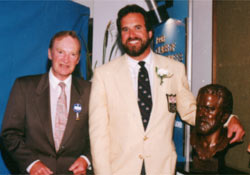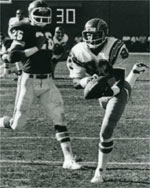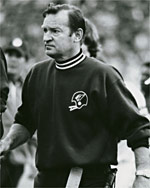
Flying High With Air Coryell
Don Coryell's Pass-Happy Schemes Made NFL Defenses Cringe
By Tom Barnidge
Those who know him best will tell you that Don Coryell is a straight-talking guy. He wears his emotions on his face. Honesty has been a hallmark everywhere he has coached.
So there is no reason to doubt his word when he says that he started out as a "run-first" coach. "We used the I-formation way back in 1955 before we even knew the name of it," he says, remembering a stint at Wenatchee [Washington] Junior College. "We called it 'backs right' and 'backs left.' You know, Power-I right and left. Back then, I was strictly a running coach."
Defensive backs who patrolled NFL secondaries in the 1970s and 1980s might find that hard to believe. What they more likely remember about Coryell's teams are long Sunday afternoons spent in full flight, receivers scattering like kids in a toy store, and spiraling passes falling from the sky without stop.
For 14 NFL seasons-five at the helm of the St. Louis Cardinals and nine with the San Diego Chargers-Coryell stalked pro football's sidelines wearing a glare that could melt lead, and dedicated his life to creating offensive schemes designed to lay waste to any defense in his path.
His singular goal: to move the football. His vehicle of choice: the forward pass.
"Every coach tells his players not to look past the next game," former Raiders safety Mike Davis remembers. "But when we used to look at the schedule at the beginning of the year, we skipped past Seattle and Denver and Kansas City until we found the games against San Diego. It seemed like they were written in large, capital letters. We called them 'Oh, Lord!' games, as in, 'Oh, Lord, here they come!' You knew that when you played them it would be raining footballs from start to finish."
 |
|
Don Coryell presented Dan Fouts into the Hall of Fame in 1993.
|
In San Diego, the coach gained his greatest fame and the team came to bear his name. It was a label born of whimsy, a humorous allusion to San Diego's baseball team. At that time, the baseball Padres traveled to road games on Air Kroc, the private jet belonging to club owner Ray Kroc. When the Chargers went airborne to arrive in opposition end zones, they were said to be traveling via Air Coryell. But it was no joke to the rest of the league.
For a record-setting six successive seasons (1978-1983), and in 1985, the Chargers led the NFL in passing yardage. Quarterback Dan Fouts passed his way into the Pro Football Hall of Fame while directing this offense. Tight end Kellen Winslow and wide receiver Charlie Joiner earned admission to the Hall by serving as his targets. The Chargers might not have been the best team in the NFL, but they unquestionably were the most exciting team to watch.
The Chargers lit up scoreboards like a Fourth of July night, whether in victory or defeat. In 1981 and 1982, they led the league in scoring. In 1979, they tied for second. Over a span of 57 games from 1979-1982, they averaged 28 points per game. No opponent was too potent and no field was too long to keep the Chargers out of the end zone. Defenses merely were speed bumps on the path to the goal line.
 |
|
"JJ" - John Jefferson
|
"A lot of teams had thrown the ball before," says John Jefferson, a glue-fingered wide receiver for the Chargers from 1978-1980, "but not in the way Coryell designed the offense. We utilized the entire field and every weapon we had, from fullback to tailback to flanker to wide out to tight end. We didn't feature one player-Coryell's system was designed to go to the open man. He'd diagram plays that would get every receiver into the game plan. San Francisco picked up on that with the West Coast offense and did the same thing."
The seeds of Coryell's philosophy had been planted nearly two decades before, when he inherited a lightly regarded San Diego State team that had posted a 1-6-1 record in 1960.
Using a balanced attack, he promptly engineered a turnaround to 7-2-1, followed by four nearly identical seasons. But each season was blemished with two defeats, a recurrence that troubled him. There were certain teams on his schedule, he finally decided, that simply were too big and too talented to be beaten by conventional means.
"If a team is physically stronger than you are," he says, "you're not going to beat them by running the ball. I thought if we put the right athletes in the right positions, we could make some points, and the other teams would be forced to try to outscore us."
The philosophy that took root at San Diego State attracted a steady supply of skill-position talent. Future NFL quarterbacks Don Horn, Dennis Shaw, and Brian Sipe honed their passing skills at the School of Coryell. Future NFL receivers Haven Moses, Gary Garrison, and Isaac Curtis ran pass routes there. A little football school of no previous acclaim had found a distinctive niche.
"Don's program was born of necessity," Sipe says. "At a school like San Diego State, he couldn't recruit the big horses he needed to play smash-mouth football. So he won the only way he knew how, by neutralizing the size difference. We had a 180-pound tight end who wasn't big enough to do any blocking, so Don put him in the slot. From there, he could wreak havoc by running patterns inside against linebackers who couldn't cover him. It was typical of Don to do something no one else would do-and not being afraid to try anything."
School records set by Coryell's teams that remain unequaled three decades later attest to the effectiveness of his innovations: total yardage in a single game (769 against New Mexico State); touchdown passes in a season (43, in 1969); longest unbeaten streak (31 games). His 1966 and 1969 teams finished with 11-0 records; 6 of his 12 teams won at least nine games in a season.
Coryell's 104-19-2 record at San Diego State-he is the only coach to win 100 games both in college and pro football-was his ticket to the NFL. The St. Louis Cardinals, a team in need of inspiration after back-to-back 4-9-1 seasons, introduced him as their new coach on January 18, 1973.
"His first year with us [another 4-9-1 record] wasn't any better than the previous two had been," former quarterback Jim Hart remembers, "and yet at the end of that year everyone felt like there were some good things about to happen. He realized we had the talent to open up the offense. And when Don got focused on something, it consumed him. He was electrifying. He made you feel like you wanted to go to war with him."
In 1974, the Cardinals bore Coryell's signature. The players embraced his offense, and he delivered a divisional championship. He unveiled an option-passing system that enabled the quarterback to size up pass coverage and pick its weakest spot. He introduced an outrageous flea-flicker play that required a cross-field lateral-and resulted in an 81-yard completion against the Dallas Cowboys. He turned running back Terry Metcalf into a run-or-catch threat who led the NFC in all-purpose yards, and helped transform wide receiver Mel Gray, an accomplished collegiate sprinter, into one of the most terrifying deep threats in the game.
 |
|
Coryell was named NFL Coach of the Year in 1974
|
With an offense that could strike from any distance, no game was out of reach. And no opponent could take a deep breath against a comeback-happy team that came to be known as the "Cardiac Cardinals." By the end of the regular season, Hart led the NFC in touchdown passes, the Cardinals were 10-4, the franchise had its first playoff berth in 26 years, and Coryell was voted NFL coach of the year by his peers. "My proudest accomplishment," he says of the acknowledgement. "It showed that I belonged in the NFL."
A year later, he proved it was no fluke when the Cardinals successfully defended their NFC East title.
But not all of Coryell's achievements could be attributed simply to Xs and Os. Jim Hanifan, Coryell's long-time assistant and one of his closest friends, says much of the coach's success sprang from his uninhibited approach to the game.
"He is one of the most enthusiastic individuals you'll ever meet," Hanifan says, "and his attitude permeated the entire football team. The players knew that he cared about them, he cared about the game, and he was going to put them in the best position he could for them to succeed each week. They believed in him.
"When we first came to St. Louis, we were at practice one day when Jimmy Hart completed a deep pass down the middle to Jackie Smith. Now, Jackie was a veteran-he'd been the league for ten or twelve years-so he didn't think there was anything spectacular about making a catch in practice. But when he turned around, right next to him running full speed, was Don Coryell, and he's shouting, 'Great catch, Jackie! Atta go! Atta go!'
"Jackie came over to me with a stunned look on his face and said, 'I've never had a coach do something like that. My God, this guy is something else.'"
Continued>>>



